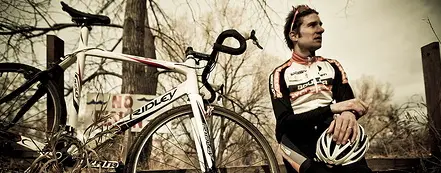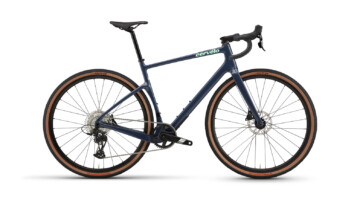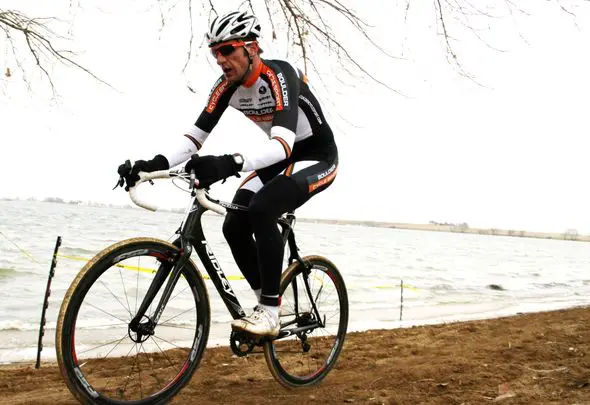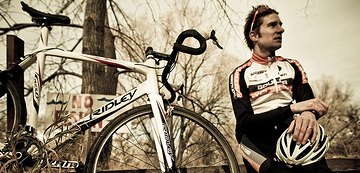 by Kat Statman
by Kat Statman
Yesterday we brought you part one of Kat’s interview with Greg Keller, Masters ’crosser and blogger of Mud and Cowbells. Read on for Keller’s thoughts on Europe, Louisville and the shape of cyclocross to come.
The past two winters Pete Webber has had huge success in Europe, and many other riders have continued to show the depth of Masters racing. Is the success of the American Masters racers in Europe helping the opinion of US ’cross in Europe?
The answer is absolutely yes. I say this definitively because I am friends with the other parties they are racing against, like Mario Lemans and other members of the Belgian crew that I raced against when I was over there. Since 2008 we have continued a great dialogue through email and texts about our racing seasons. Another example would be Edwin Raats, a multiple-time world and Dutch champion, an extremely classy rider who calls himself the absolute Masters racer: he was never a professional and yet has such amazing genetic gifts. When Brandon [Dwight] and Pete have gone over they have shown what the US Masters racers are capable of. Even moving Brandon and Pete aside, both of whom have been able to call themselves pro in past lives, look at the successes of Michael Robson, Ward Baker, Brian Hludzinski, Kurt Perham. All of those guys are my dear friends and teammates and we crush each other every weekend.
It just goes to show that the fields in the US are deeper with talent. There is a sort of natural selection going on in the US, where we are forced to train and be in the front of more racers. The training is different, the field sizes are different, thus you are going to have a deeper field. The Masters fields in Europe are age group to age group between 10-15, and they will cluster together age groups to make 30-40 racers total; you are talking about orders of magnitude compared to any single Masters fields in the US. It just goes to show you how deep our fields are getting. By deep I don’t mean just size, but also the numbers of riders capable of riding at the front, and that talent is getting better.
The US Masters really put on a show in Mol, Belgium, this year [at Worlds]. Is this a good sign for Louisville with our American-style course and the different type of courses we see here in the US, with our grass crit style of racing?
I definitely agree. That being said, Mol is an extremely hard course. There is no hiding in Mol. The racing in Louisville will be different. It will prove that the strongest guy is out front because Louisville presents a lot of openness and the ability to pass, assuming it is something similar to the USGPs we’ve seen.
The other question is “how international will the field be?” I am starting to talk to some friends overseas, and some of them had no idea that Masters Worlds is leaving Mol. There has to be an education in Europe to tell people that Masters Worlds is in Louisville. I am praying that it does get good exposure. It’s a great place to have a ’cross course, it’s on the East Coast, it’s not that hard to get to. You can fly into Cincinnati if you have to.
Do you think the American Masters’ results affect the respect Americans get on the Elite side?
It’s a completely different picture. That type of thing doesn’t trickle upstream. But you are seeing folks who grew up with cycling, like me, where our generation’s children are embracing the sport, more globally in the US.
Why aren’t the Europeans paying as much attention to what’s happening in the US? We have Jonathan Page, Tim Johnson, Jeremy Powers, all who have fairly consistently been in the top 20 at World Cups. Tim has spent most of the season in the US and then was riding in the top 10 at Hoogerheide.
Their vantage point is different, people like [Adri] van der Poel know what is going on in the US. To the fans in Europe who come in at 15-20 euro per head, they still think the Americans are a sideshow. Jonathan Page is a sideshow, he isn’t week in, week out slaying guys like Pauwels and Nys. The real die-hard fans are starting to respect Page, they can see that he is an accepted son, but that’s it. It’s Jonathan Page. Everyone else, they come in, dip their toe in the water, they get their shit kicked in and they come back to the US. There is a non-influence. “Look at how slow they are,” and the only reason Page isn’t is because he is here.
How do you change that? I don’t know. You have Juniors or U23s who will have to spend their entire season there. Maybe you have kids who do exchange programs with universities and they try to study and maintain a quasi-professional racing calendars to get up there with guys like Joeri Adams, who are professionals but just are too young to race with the Elites.
You can’t just go and show up and expect to kick ass for a week in December.
Your original question is about the perception of American ’cross. You have to have look at it from the perspective of the person in the Wellingtons, smoking cigarettes and drinking the Trappist beers, lining the tape. Yeah, you have Page who got a typical 12th today and all the other clown Americans are in the 20s or 30s. Johnson and Powers, who are dear friends of mine, would say the same thing. You have to be constantly over there and/or living there to make a mark.
There is obviously the geographic difference between the US and Europe. Do you think some of it is the volume of racing, 40 ’cross races a year versus 25-30?
The top-caliber events are close together at strictly a professional level. Over here the country is huge, you can’t expect to cluster a bunch of professional events in one area every weekend. Traveling is part of it and most of our big events have a month in between each other. Really the best person to talk to about this is Adam Myerson [We have spoken to Adam earlier this year on The Future of American ’Cross].
Everyone talks about the difference between US and Euro courses. Those courses are for the Elites allowing them to be more technical, with steep drops and run-ups. Do you think that we should strive to have more technical courses here in the US, or should we promote the American brand of ’cross courses?
I’ve written a blog post about this on the “Starbucked courses” we have. I say, the more technical the better. I don’t think that they need to be mountain bike technical. They need to be technical to show off the best riders’ capabilities of maintaining speed and fluidity. How do you do that? The net answer to that is you need bring back barriers and obstacles to show off the true athleticism of cyclocross riders. Grass crits are not an equalizer enough, anyone can show up and win a grass crit, but not anyone can show up and win a ’cross.
That being said, some of these courses in Belgium are off-the-charts dangerous. These ridiculous drop-ins that aren’t ready for non-suspended bicycles, and I’m sorry, but tubulars do not equal suspension. At the bottom of these things you see the gaggle of brown-suited emergency crews waiting for the broken neck or the pile up. That’s not fun at all, that is dangerous. Anyone can dive their bike down a steep pitch. There has to be a balance.
We don’t want more broken backs like Niels Albert a few years ago.
Exactly, and that guy is a sick bike handler.
Where would you like to see American ’cross in 5 to 10 years from now?
Starting at the top, I envision USAC has a viewpoint now to accelerate younger riders into a program that has them spending more time abroad, obviously not sacrificing education, find some sort of balance for that and a program that reinforces that. Also I’d like to see if racing in the US could get to a point where our events can get monetizable. The Euros have cracked that code the last 40 years. We still think bike racing in the US is a joke, you can just go out to the side of the road and then go back into the house and drink your bud and watch NASCAR again, assuming that a race goes by your house. In this case ’cross racing eventually should be a destination point where you come in, buy tickets, enjoy the day, have a beer on course and watch multiple races, from Pros to Masters and you pay 5 to 10 bucks to get in and enjoy the atmosphere. You see guys like Brook Watts who grew a set of balls and gated off the area charging people to come in at ’Cross Vegas. Now, he didn’t do this to make money, but just to break even. But it shows you that it can happen, where people will come and pay to be there. And of course, yes it’s a built-in thing because it’s Interbike, but it is still doable. At places like Louisville, or the Bay Area of Calif., or Valmont bike park, you can have regions where you can block off the area and have a funnel point to charge spectators to enjoy it. That is a digression, but you see the point. We need programs to help professionalize the sport here by way of its athletes and events like we see in Europe.
This view is not far off Trebon’s opinion (See Ryan Trebon Interview: Opening Up and Shutting it Down).
You want to see ’cross grow in terms of its numbers, but where do you want to see things move in terms of the lower categories, events, etc.?
You can’t have the cake and eat it too. Without question I want to see people enjoy and love ’cross as much as I have the last 15 years. The problem is, in my experience, we have seen the fields grow from 10 dudes in a church or school parking lot. Now we are dealing with 1,600 racers in a weekend in Portland. We may need to get to a point like in the 70s and 80s with BMX. We may need to understand how you build an effective schedule for a day or weekend to make sure that the best end up on top and are where they need to be. Maybe a heat system. Maybe a morning time trial or a heated event. I don’t know, I am making this up as I go. In that way you may have to race three or four times on Saturday for one lap. Maybe Sunday is the main event where it is only the top 40 guys from the day before. Something to maintain and preserve what ’cross is meant to be. Shortish laps, so we don’t have to change course distance or anything to accommodate field sizes. We do something else to accommodate the amount of people that can line up for a main event.
Tim announced this year that he is retiring from road racing to focus on ’cross. What are your thoughts on now having two Americans able to make a living racing ’cross?
It’s great. I think it’s proving a point. It’s a lifestyle thing. Tim and Jonathan are core ’crossers. Let’s be honest. These guys aren’t bank rolling benzo’s or anything like that. They have been successful US-based bike racers and have achieved the opportunity in their carriers to make this choice. And their lifestyles are such that they can support this. Should more people do that? I can’t dictate how people want to live their lives. There isn’t enough money, for many people, especially if you are married and have children unless you are in the top and pulling down what Stybar is making, 500k plus 10k for start fees. To even get close to that you have to be living in Europe and racing the biggest events. That is the only way to really make it.
Thanks Greg for your time and we look forward to hearing your continuing story as you live the dream!
























